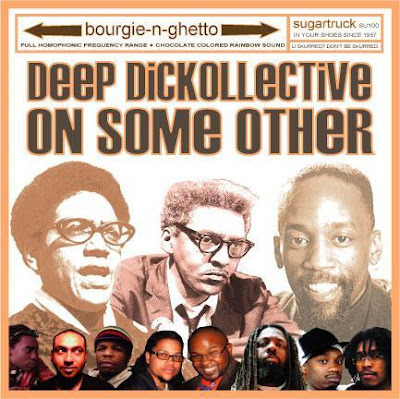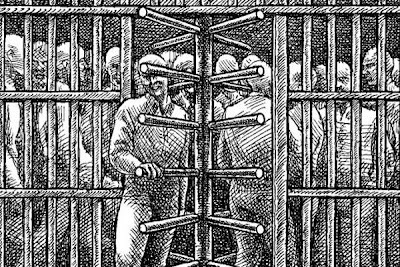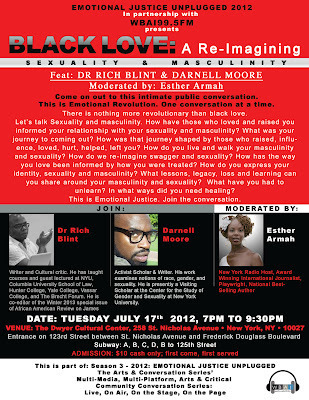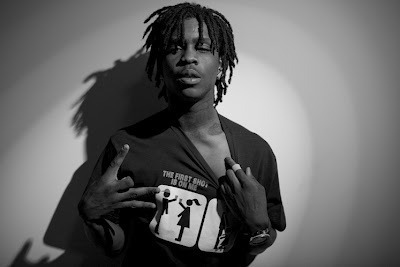Mark Anthony Neal's Blog, page 981
July 10, 2012
Hank Willis Thomas on the Role of the Artist
ArtLogVideo
HANK WILLIS THOMAS is a photo conceptual artist working with themes related to identity, history and popular culture. He received his BFA from New York University's Tisch School of the Arts and his MFA in photography, along with an MA in visual criticism, from California College of the Arts (CCA) in San Francisco.
Published on July 10, 2012 09:23
DeepDickollective Co-Founder Tim'm West on Frank Ocean

An Open Letter to Frank Ocean by Tim'm T. West | special to NewBlackMan (inExile)
Good day, Brotha Frank Ocean
I am a member and founder of the now-defunct Deep Dickollective referenced in the NY Times piece written by James C. McKinley, Jr. and published on my 40th birthday. We achieved a great deal of critical success in the 10 years we moved crowds Bay-area and beyond; and those years offered a platform for continued work as an openly gay-identified solo artist. It was refreshing to be honored for perhaps being a stepping stone in creating a world where you could reveal yourself with a great deal more support than the forced invisibility so many talented gay and bisexual artists have been met with. You present an opportunity to be a game-changer when many have sought a formula for acceptance.
I can't honestly say that I was familiar with your body of work, prior to your coming out letter. Many people assumed that I knew you but I won't front. I should be familiar with you, based on your talent alone, but as an indie artist with little hope that the market will ever honor the "real" of how black men live and breathe beyond the often hyperbolic, braggadocio-filled caricatures we see in media, I'd pretty much tuned out. Still, I can say that I'm proud of you. Your letter alone made me a fan; but on the eve of your highly anticipated release I felt I'd be remiss not to offer my support for the cultural impact your disclosure may have on the youth cultures shaped largely by Hip-Hop & Soul music.
I am writing namely to congratulate you for your courage to "let people in" rather than the "coming out" many call it. "Coming out" makes such a spectacle of the simple truth about what love can move one to do. Your letter and your loving are simply the "real" so often referenced in a Hip-Hop that seems to be more committed to swag than seriousness. My good friend Karamo Brown once challenged me to see self-revelation about sexuality, not as "coming out" of hiding, but "letting others in" to your truth. The former is so often associated with shame and secrecy, that I've grown to appreciate the distinction. My reaction to your letter and the responses that it has generated (many affirming) is probably more ambivalent than some might expect. It has become trendy for people to support being real in Hip-Hop about homosexuality, even when little support and resources are put in the service of elevating LGBT artists or supporting a world where they can be heard. Being an ally doesn't mean you don't join the mob who decides to beat the gay down. It's the more active fight, before the fight, that honors human dignity enough to keep the mob from even forming.
Remember that your triumph is personal. You capture the poetry inherent in "the love that dare not speak its name" when you courageously decide to sing it. Understand this: Those who take issue with your sexuality? They have the issue. Please don't confuse other people's "baggage" with your clarity of feeling-- beautifully executed in the letter-gone-public originally written in December 2011. Feel no pressure to "represent" anything beyond a brotha who has decided to huMAN up and honor the volition of his heart. Your loving is political because it shouldn't have to be. You describe feelings similar to my 20 year search to find the life-partner I'm convinced I'll grow old with. Remember that as a lover of music, and songwriter, you have the ability, freedom, and platform to represent a range of human emotions and experiences. That said, as much as the market will try to shape who you are into a product, never betray your process. Continue to "keep it real" in ways many who criticize you would have never been able to do. Hold those accountable who say they have your back to put their money where their mouth is: market success requires support I believe you already have and will continue to have. It's great timing. With the President's recent endorsement of Gay Marriage, many are being asked to declare where they stand. Stand for something, brother.
Lastly, when love knocks on your door again, remember: It's not about Hip-Hop, or "realness", or Gay Marriage platforms, or the 2012 election; provided it's even a male who you decide to share your love with. Your song is a truth that, like opening your heart to love, quite simply takes your breath away. At 40 I'm embracing that feeling like I never have before. Beyond beats and rhymes, there is the breath, once broken and labored, that sustains you. Breathe easy knowing you've already arrived and worked hard for the success you'll receive. Nothing can be further from your truth.
Props and Congratulations.
Tim'm T. West
***
An educator, artist and scholar, Tim’m T. West is a founding member of the DeepDickollective. His most recent recording is Fly Brotha (2011).
Published on July 10, 2012 08:16
Grassroots Effort Launches to Reform NYC Jails, Combat Culture of Brutality at Department of Correction

FOR IMMEDIATE RELEASE:Monday, July 9, 2012 CONTACT:Emma Woods, 646-200-5303/203-568-4780, emma@berlinrosen.com
Grassroots Effort Launches to Reform NYC Jails, Combat Culture of Brutality at Department of Correction
NYC Has One of the Highest Rates of Solitary Confinement in U.S.By 2013, NYC Department of Correction (DOC) Will Have Increased Solitary Confinement Cells by 69%
Lawsuits against Correction Officers Cost City Millions, Yet Funding for Officer Training Down 40%; Top DOC Officials Have History of Brutality
New York, NY– A grassroots effort to reform New York City jails launched with a protest outside a meeting of the Board of Correction, where NYC Department of Correction (DOC) Commissioner Dora Schriro was present. The protest marked the first public action of the New York City Jails Action Coalition, a collection of activists working to improve conditions, stop the use of solitary confinement, and increase transparency and accountability at the DOC. As the Commissioner and Board Members entered the building, activists held signs calling out the DOC’s most brutal officers.
Amidst a national conversation on ending the abusive practice of solitary confinement, the NYC Department of Correction is partway through its plan to increase solitary confinement capacity by 69% by the end of Fiscal Year 2013. New York City jails have one of the highest rates of solitary confinement in the U.S.— by FY13, NYC’s rate will be up to five times the national average, with 9-10% of the jail population in solitary confinement at any one time.
DOC Commissioner Dora Schriro calls the DOC’s punitive segregation policies“progressive and highly effective.” Yet a United Nations expert on torture recently declared that solitary confinement should be banned as a jail punishmentand reserved for only the most extreme situations. Meanwhile, states across the country—including Mississippi, Maine, Ohio, Illinois, Colorado, and Washington State—have made efforts to reduce the number of people in solitary confinement and rethink the criteria used for placing people in isolation. Notably, Mississippi’s efforts resulted in a decrease in violence and a cost-savings for the state.
“At a time when solitary confinement is being nationally acknowledged as abusive and inhumane, New York City’s choice to expand this brutal method of punishment is unconscionable. Although New York State has acknowledged the horrors of solitary confinement by enacting the SHU Exclusion Law, which diverts people with serious mental illness from solitary confinement into treatment units, New York City’s DOC has turned a blind eye,” noted Alexandra Smith, MSW, who received a 2008 Soros Justice Fellowship to advocate for implementation of the state law.
“NewYork City uses solitary confinement to punish the most banal offenses, from‘horseplay’ to ‘noisy behavior.’” said Richard Sawyer, JAC member and student at NYU School of Law. “The DOC uses solitary as the first resort when it should be the last.”
The coalition is also taking aim at the culture of brutality in the DOC. Each year, the City spends millions settling lawsuits filed against corrections officers for brutalizing inmates. Between 2003 and 2011, brutality lawsuits settled by DOC cost the City well over $5 million.
While allegations of abuse skyrocket, funding for correction officer training is down 40% over the last decade. Not only does the DOC tolerate abusive tactics, the coalition asserts, but it rewards them, with some of the worst offenders promoted to positions of leadership in the DOC. According to a class action lawsuit filed by The Legal Aid Society at the end of May 2012:
▪ Deputy ChiefCarmine LaBruzzoserved as a captain in the Central Punitive Segregation Unit (CPSU), the main solitary confinement facility, from 1996-2003, when he was charged with personal involvement in no fewer than six use of force violations.
▪ Assistant Chief of SecurityMark Scottwas suspended for 42 days in 1997 after an Administrative Law Judge found that he had struck a prone incarcerated individual with his baton “as though he were spear fishing.”
▪ As Assistant Deputy Wardenof the CPSU, Eric Ramosallegedly lured an inmate out of his cell in 2002 and instructed his officers to beat the inmate, according to the Ingles v. Toro class action. Since he took command, inmate complaints of excessive force in the CPSU have increased dramatically. Ramos is now the highest-ranking officer at the CPSU.
▪ While Captain in the CPSU in the mid-1990s, Ronald Jorgenson was observed brutally assaulting an individual and was reported to the Deputy Warden of Security. He was not disciplined, but was later promoted to Deputy Warden for Security at the Anna M. Kross Center (AMKC).
▪ While assigned to the CPSU in the mid-1990s, Emmanuel Bailey was notorious for his involvement in assaulting individuals incarcerated there. An officer who later became an FBI informant saw Bailey assault an individual and then cover it up. He wassubsequently promoted to Warden of the Robert N. Davoren Complex (RNDC), where he was in charge of a notoriously violent youth facility where gang members are said to enforce discipline at the behest of correction officers.
“Family members are outraged at the continued brutality, poor mental health services and lack of accountability at Rikers Island,” stated Leah Gitter, member of Rights for Imprisoned People with Psychiatric Disabilities. “Our loved ones should not be subjected to such extreme punishment and cruelty. It is time to make changes at Rikers to stop these horrendous practices.”
“I worked with a 17-year-old for months before he felt comfortable sharing hisstory with me. When he was then put in solitary confinement and humiliated on a daily basis by officers, he became so depressed; there were days he wouldn't talk,” recounted Megan Crowe-Rothstein, LMSW, Director of Social Work at Urban Justice Center’s Mental Health Project. “It was so painful for me to see him suffering – I can only imagine how he survived, or how anyone does, in those conditions.”
In the coming months, the NYC Jails Action Coalition plans to request that New York City adopt rules to severely curtail solitary confinement.
ABOUT THE NEW YORK CITY JAILS ACTION COALITION:
The New York City Jails Action Coalition is a grassroots collection of activists, including the formerly incarcerated, currently incarcerated, family members and other community members, working to promote human rights, dignity and safety for people in New York City jails. Our goals include: Increasing transparency in Department of Correction (DOC) policies in NYC jails and accountability for DOC practices and abuses; ending the use of solitary confinement (punitive segregation, SHU, the Box, the Bing) in NYC jails and opposing the DOC’s planned increase in punitive segregation cells; addressing the medical and mental health needs of people in NYC jails and ensuring access to continuing care in the community upon release; advocating for more rehabilitative services in NYC jails to promote reintegration; and fighting against the racist and discriminatory policies leading to mass incarceration.
###
Published on July 10, 2012 06:03
July 9, 2012
"Gathering of Leaders": Khary Lazarre-White of The Brotherhood/Sister Sol
Khary Lazarre-White of The Brotherhood/Sister Sol
From the "Gathering of Leaders" Interview series | Robert Wood Johnson Foundation
Published on July 09, 2012 16:58
Southern Cosmology: Love Letter to Atlanta | mixed & selected by Dj lynnee denise

moved to Atlanta from Brooklyn in March 2011 as a part of a Great (Re) verse Migration. Since being here I've been inspired by the calm of the breeze, the soul of the people and the movement on the dance floor. In circles we dance to house music, fed by rhythms that translate ancestral languages. Bass. With this mix I want to give back to ATL the love I've received, the creativity that's swinging from the history of these trees...and this dirt. Red Clay. My ancestors, my future. Take a musical journey with me as I mix some of my favorite songs from the past 3 months, some of it South African and all of it soulful and deep. I write you now from an airplane on my way to Aruba to teach babies what it is to be rooted in Music and versed in Technology. Arts Rules Aruba 2012.
From the people who bring you The Chitlin Circuit: Deep House in the Deep South, we now offer to the space Southern Cosmology: Love Letter to Atlanta.
Now Dance.
dj lynnee denise
Published on July 09, 2012 15:39
BLACK LOVE: A RE-IMAGINING: Swagger, Sexuality, Identity, Masculinity - An Intimate Public Conversation

EMOTIONAL JUSTICE UNPLUGGED 2012In partnership withWBAI99.5FM
presents
‘BLACK LOVE: A RE-IMAGINING’ : Sexuality & MasculinityFeat: Dr. Rich Blint & Darnell MooreModerated by Esther Armah
Come on out to this intimate public conversation.
This is Emotional Revolution. One conversation at a time.
There is nothing more revolutionary than black love.
Let’s talk Sexuality and masculinity. How have those who loved and raised you informed your relationship with your sexuality and masculinity? What was your journey to coming out? How was that journey shaped by those who raised, influence, loved, hurt, helped, left you? How do you live and walk your masculinity and sexuality? How do we re-imagine swagger and sexuality? How has the way you love been informed by how you were treated? How do you express your identity, sexuality and masculinity? What lessons, legacy, loss and learning can you share around your masculinity and sexuality? What have you had to unlearn? In what ways did you need healing?This is Emotional Justice. Join the conversation.
Join:
Dr Rich Blint - Writer and Cultural critic. He has taught courses and guest lectured at NYU, Columbia University School of Law, Hunter College, Yale College, Vassar College, and The Brecht Forum. He is co-editor of the Winter 2013 special issue of African American Review on James Baldwin.
Darnell Moore - Activist Scholar & Writer. His work examines notions of race, gender, and sexuality. He is presently a Visiting Scholar at the Center for the Study of Gender and Sexuality at New York University.
Moderated by:
Esther Armah – New York Radio Host, Award winning international journalist, Playwright, National best-selling author
DATE: TUESDAY JULY 17 2012TIME: 7PM TO 9.30PM
VENUE: The Dwyer Cultural Center, 258 St. Nicholas Avenue • New York, NY • 10027 Entrance on 123rd Street between St. Nicholas Avenue and Frederick Douglass BoulevardSubway: A, B, C, D, B to 125th Street
ADMISSION: $10 cash only; first come, first served
This is part of Season 3 - 2012 ‘EMOTIONAL JUSTICE UNPLUGGEDThe Arts & Conversation Series’Multi-Media, Multi-Platform, Arts & Critical Community Conversation series: Live, On Air, On the Stage, On the Page
Published on July 09, 2012 06:18
July 8, 2012
A New Way Out: Melissa Harris Perry & Michael Eric Dyson on Frank Ocean
Published on July 08, 2012 18:28
Serena Williams: "Ain’t I a Champion?"

Serena Williams: "Ain’t I a Champion?" by David J. Leonard | NewBlackMan (in Exile)
On Saturday, Serena Williams captured her 5thWimbledon title (later in the day, she and Venus would secure a double’s title as well). Since 1999, the Williams sisters have captured 10 titles at the all-England club. Yet, for each of them, this success has not come without trials and tribulations. Over the last few years, Serena has suffered countless injures, including a blood clot in her lungs. Battling insomnia, depression, physical ailments, and the tragedy of her sister’s murder, Serena has overcome obstacles far more challenging than a Sharapova backhand. “I definitely have not been happy,” Williams announced in 2011. “Especially when I had that second surgery (on my foot), I was definitely depressed. I cried all the time. I was miserable to be around.” In other words, Serena Williams has secured greatness on and off the court, thriving in spite of tremendous hardship.
Within a culture that thrives on stories of redemption, that celebrates resilience and determination, the career of Serena Williams reads like a Hollywood screenplay. Yet, her career has been one marred by the politics of hate, the politics of racism and sexism. Last year I wrote about the treatmentshe has faced from fans and media alike:
What is striking about the comments and several of the commentaries as well, is the demonization of Serena Williams. Focusing on her body (reinforced by the many pictures that sexualize Williams), her attitude, and her shortcomings as a player, the responses pathologize Williams. “The Williams sisters have been criticized for lacking ‘commitment’ by refusing to conform to the Spartan training regime of professional tennis, restricting their playing schedules, having too many ‘off-court interests’ in acting, music, product endorsements, fashion and interior design, and their Jehovah’s Witness religion” (McKay and Johnson).…
“The Williams sisters also have been subjected to the carping critical gaze that both structures and is a key discursive theme of ‘pornographic eroticism’,” writes James McKay and Helen Johnson. Similarly, Delia Douglas argues, a “particular version of blackness” is advanced within the representations of the Williams sisters. We see the “essentialist logic of racial difference, which has long sought to mark the black body as inherently different from other bodies. Characterizations of their style of play rely on ‘a very ancient grammar’ of black physicality to explain their athletic success”
This monumental victory also didn’t lead to a celebration, a coronation of the greatest player of her generation (and maybe in history), but instead more of the same. The story of redemption and the beauty of her game isn’t the story found throughout the cyber world, from twitter to the comment section of various sports websites.
Her victory prompted tweets referring to her by the “N Word” and several more about her body and sexuality. Reflecting an atmosphere of racist and sexist violence, of dehumanizing rhetoric, tweets referring to her as a gorilla flowed throughout cyberspace with great frequency (some of the below appeared over the last week).
· Today a giant gorillaescaped the zoo and won the womens title at Wimbledon... oh that was SerenaWilliams? My mistake.
· Serena Williams is a gorilla
· Watching tennis and listening to dad talk about how Serena Williams looks like gorillafrom the mist
· I don't see how in the hell men find Serena Williamsattractive?! She looks like a male gorilla in a dress, just saying!
· You might as well just bang a gorilla if you're going to bang Serena Williams
· Earlier this week I said that all female tennis players were good looking. I was clearly mistaken: The Gorilla aka Serena Williams.
· serena williamslooks like a gorilla
· Serena Williams is half man, half gorilla! I'm sure of it.
· Serena Williams look like a man with tits, its only when she wears weave she looks female tbh, what a HENCH BOLD GORILLA!
· Serena Williams is a gorilla in a skirt playing tennis
· My god Serena Williams is ugly! She’s built like a silver backed gorilla
· I would hate to come across Serena Williams in a dark alley
· Serena williamsis one of the ugliest human beings i've ever seen
YouTube posts offered similar responses to her victory:
· A man? look at her body, more like a silver back gorilla. I can easily imagine her charging through the jungle breaking trees while flexing those muscles. Doesn't help that her nose looks like a gorillas as well. I keep expecting to see her zoo handlers to chain her up after the match before she can escape.
· Monkey business
· i ddntknow apes wer allowed in women tennis O_O
It would be a mistake to dismiss these comments as the work of trolls or extremists whose racism and sexism put them outside the mainstream. Just as the Obamas, just as Dr. Christian Head, just as Mario Balotelli was depicted as King Kong in a recent cartoon, and just as just as soccer and hockey players from throughout the Diaspora face banana peels and monkey chants, the racism raining down on Serena’s victory parade highlights the nature of white supremacy. It embodies the ways that white supremacy demonizes and imagines blackness as subhuman, as savagery.
Frantz Fanon, with his seminal work “The Fact of Blackness,” concludes that irrespective of clothing, irrespective of profession, irrespective of employment status, behavior, and/or success; irrespective of victory of defeat, blacks are denied humanity within the white imagination. Blackness is to be savage and inhuman; it is to remain dirty, dangerous, destructive, and dysfunctional, all while maintaining a relationship to the “ontology of whiteness,” which is assumed to embody “rationality and universality” (Bhabha 2000, p. 355). Bhabha makes this clear:
The black is both savage (cannibal) and yet the most obedient and signified of servants (the bearer of food); he is the embodiment of rampant sexuality and yet innocent as a child; he is mystical, primitive, simple-minded and yet the most worldly and accomplished liar, and manipulator of social forces. In each case, what is being dramatized is a separation – between race, cultures, histories, within histories – a separation between before and after that repeats obsessively and mythical moment of disjunction (Bhabha in Location of Culture, p. 118).
The constant references to Serena’s physical body, and the desire to attribute her success to power and strength, reflects this process as well. In the aftermath of the victory, ESPN ran a column with a headline of “Serena rides savage serve to title” (the title has been changed as of writing). Playing upon a the rhetorical and discursive landscape used to describe African Americans as uncivilized animals/savages, the use of the word “savage” is neither appropriate or accurate (not too mention offensive and terribly troubling).
Her victory and her greatness doesn’t come purely from her power and physical domination but from the artistry of her game, from her intelligence and hard work, and from the precision and quality of her shot-making. In attributing Serena Williams’ success to her animalistic essence, to ridicule and mock, and to otherwise deny her the rightful praise earned, the online chatter and the larger media perpetuates the project of white supremacy. It denies her greatness while imaging her as an Other within and beyond the tennis world.
In interpreting her Wimbledon victory through this language of white supremacy, the virtual discourse also works to define her place within tennis as undesirable and suspect. Imagined as the Other, blackness exists as perpetual outsider. The demonization, the efforts to dehumanize, to ridicule and mock, and to otherwise depict her as “unlike the normal” and therefore suspect and undesirable, establishes the boundaries of whiteness.
As Andreana Clay recently noted it is part of a culture that makes clear that tennis is “somewhere she doesn't belong.” It reflects a process establishing the boundaries of whiteness within tennis, whereupon her black female body is subject to scorn and regulation. It embodies an effort to deny and silence her greatness, to “put her in her place” and to otherwise maintain the dominant racial ethos.
Given this context, it is not surprising how much her victory meant to her, her family, and her fans. The excitement and joy exhibited by Serena, the celebration from fans and others (my timelines were full of pictures and comments of joy), thus, isn’t just a celebration of her greatness and her accomplishments but how her victory yet again challenges a culture of invisibility and dreams deferred. With trophy in hand, Serena Williams challenged those on and offline, announcing,***
David J. Leonard is Associate Professor in the Department of Critical Culture, Gender and Race Studies at Washington State University, Pullman. He has written on sport, video games, film, and social movements, appearing in both popular and academic mediums. His work explores the political economy of popular culture, examining the interplay between racism, state violence, and popular representations through contextual, textual, and subtextual analysis. Leonard’s latest book After Artest: Race and the Assault on Blackness was just published by SUNY Press in May of 2012.
Published on July 08, 2012 08:41
July 7, 2012
Ill Doctrine: Frank Ocean’s Independence Day
Why “coming out” without using any one label might have a power all its own.
Published on July 07, 2012 16:38
What’s Killing Our Culture? II: It’s Bigger Than Hip-Hop

What’s Killing Our Culture? II: It’s Bigger Than Hip-Hop by Adia “Dr. Dia” Winfrey, Psy.D. | special to NewBlackMan
On June 21, 2012, my piece “What’s Killing Our Culture? It’s Not the Mainstream and Tight Jeans,” was published on NewBlackMan (in Exile). Within a week, it was heavily circulated. The piece prompted “Turn Up the Dial? The Cultural Values of Black Youth Culture,” by esteemed composer and author Professor Bill Banfield. This second installment of “What’s Killing Our Culture?” will continue to explore the question. I will also reference social media accounts of scholars, youth, artists, and journalists in recognition of “Remixing the Art of Social Change,” Words, Beats, and Life Inc.’s Teach-In at Howard University.
Child literacy expert, Nikolai Pizarro (@BE_PURE), recently alerted me to the Facebook status of a high school student. Within three minutes of posting, it received seven “Likes” and the comment, “I juss gotta steal this.” The following status is a reality for many of our youth, and is the motivation for my life’s work:
Im Tired Of Yelling
Im Tired Of Being Sad
Im Tired Of Being Alone
Im Tired Of Pretending Everythings Alright When Its Not
Im Tired Of Being Alone
Im Tired Of Being Angry
Im Tired Of Feeling Crazy
Im Tried Of Feeling Stuck
Im Tried Of Missing Things
Im Tired Of Missing People
Im Tired Of Feeling Empty Inside
Im Tired Of Not Being Able To Jss LET GO
Im Tired of Wishing I Could Start All Over
But Most Of All Im Tired Of Being Tired !
The geographic origin, gender, and race of the author are irrelevant. Though initially created for Black males, I’ve conducted my Hip Hop-based group therapy program, H.Y.P.E.: Healing Young People thru Empowerment, with male and female youth of varying races across the country. This Facebook status reflects the voicelessness I consistently witness. Before they’ve had a chance to live, our youth are simply “tired of being tired.” We can’t waste time focusing on youth fashion trends, or Hip Hop debates about “underground versus mainstream” or “conscious versus gangsta.”
“Give me a gifted trap rapper over a wack "conscious" n---a any day. It's hip hop. Form >>>>>> content.” ~@Phonte via Twitter (Recording artist)
As stated in the first “What’s Killing Our Culture?” the architects of Hip Hop culture were Black and Latino youth who claimed their voices and space in spite of. Freedom of self-expression is at the heart of Hip Hop’s appeal across elements. But with this freedom comes a harshness that can become difficult to stomach. Like the litany of “gangsta” or more recently dubbed “trap” rappers before him, 17 year old Chief Keef is at the center of the “music is killing our kids” conversation. With lyrics boasting of “playing Russian Roulette, with n----s heads,” it’s easy to understand the attention Chicago’s Chief Keef is garnering.
In his piece, “Chief Keef is the Bomb,” recording artist and community activist Che “Rhymefest” Smith (@RHYMEFEST) states, “A Bomb has no responsibility or blame, it does what it was created to do; DESTROY!” Smith goes on to state, “Notice, no one is talking about the real culprits, the Bomb maker or the pilot who is deploying this deadly force.” Via Twitter, noted journalist Ferrari Sheppard (@stopbeingfamous) declares, “…Chief Keef makes me want to cry for real because it's not his fault and what he represents is a reality.” This is the power of Hip Hop Culture…it gives voice to everything, including the most heinous realities of our society. How do we respond?
History shows us the general methods being employed are futile. I vividly recall images from my childhood of pastors bulldozing 2Pac and NWA albums and tapes. Over twenty years later, these rap artists are cultural icons. Clearly this method did nothing to silence the messages or messengers. Even when the physical manifestations of its elements are disfigured, Hip Hop Culture will not be destroyed. What’s left?
“Open minds, open doors.” ~@TheRealMarcSee via Twitter (Recording artist/Producer)
Through years of research and professional experience, I’ve found Hip Hop Culture, the very source many consider to be the problem, holds the solution. When combined with time and love, which we often undervalue, Hip Hop culture can improve the outlook so eloquently expressed in the aforementioned Facebook post. Hip Hop culture opens the door forjudgment-free, engaging interactions with our youth, which reinforce their brilliance, validates their experiences, and harnesses their potential. Our youth are being targeted and destroyed from all sides, and too many continue to focus on their symptom-ology rather than the real issue, which is their pain and voicelessness.
Dr. Guthrie Ramsey (@DrGuyMusiQology), University of Pennsylvania professor said it best in a Facebook post, “Sagging? We talking about sagging?” If we continue to be lured by distractions, and subscribe to such thinking, our youth will continue to be spiritually dead, and we will only have ourselves to blame. Now’s the time…let’s get H.Y.P.E.
***
Adia “Dr. Dia” Winfrey, Psy.D, is the author of H.Y.P.E.: Healing Young People thru Empowerment (African-American Images, 2009) and has been featured on NPR, in JET Magazine, and endorsed by syndicated radio personalities Tom Joyner and Michael Baisden. Learn more at letsgethype.com.
Published on July 07, 2012 09:04
Mark Anthony Neal's Blog
- Mark Anthony Neal's profile
- 30 followers
Mark Anthony Neal isn't a Goodreads Author
(yet),
but they
do have a blog,
so here are some recent posts imported from
their feed.



